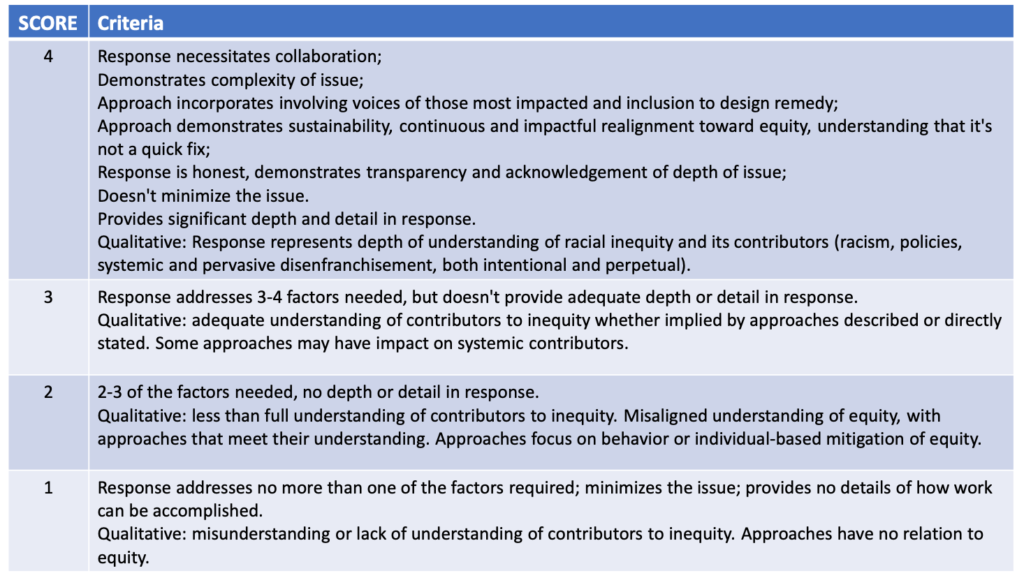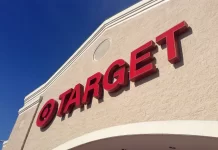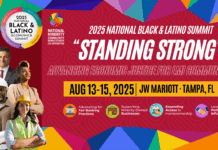This analysis of the 2021 mayoral and city council candidates in St. Petersburg, Florida explores thinking on real-world aspects of moving towards race equity. This is an inaugural assessment of candidates’ commitment to race equity, and there is no standardized way to conduct this type of analysis yet. Therefore, this process has been fluid, and the methodology has adapted as learning continued.
The survey was pilot tested by sending to persons who were presently or formerly in public office, including city council members and Florida state legislators in Hillsborough and Pinellas Counties. Comments and responses to the pilot allowed for assessment of validity of the questions to elicit responses that allowed measurement of one’s commitment to equity. Four participants completed the pilot survey by September 21, 2021. Two researchers separately coded each response individually and then met together to discuss alignment, variability, and challenges with the coding structure using the current rubric. Several issues were illuminated during this process that shaped the precision and validity of the survey. The main source of bias was identified as researchers compared the length of the responses. Using the word “some” in questions provided too much space for variability in response length. Revisions were made to ask respondents more precisely about their experiences during the course of the survey. This would provide a more equivalent baseline for coding. This process resulted in adjustments to the questions, survey format and rubric to appropriately elicit and score responses.
This analysis of the 2021 mayoral and city council candidates in St. Petersburg, Florida explores thinking on real-world aspects of moving towards race equity. This is an inaugural assessment of candidates’ commitment to race equity, and there is no standardized way to conduct this type of analysis yet. Therefore, this process has been fluid, and the methodology has adapted as learning continued.
The survey was pilot tested by sending to persons who were presently or formerly in public office, including city council members and Florida state legislators in Hillsborough and Pinellas Counties. Comments and responses to the pilot allowed for assessment of validity of the questions to elicit responses that allowed measurement of one’s commitment to equity. Four participants completed the pilot survey by September 21, 2021. Two researchers separately coded each response individually and then met together to discuss alignment, variability, and challenges with the coding structure using the current rubric. Several issues were illuminated during this process that shaped the precision and validity of the survey. The main source of bias was identified as researchers compared the length of the responses. Using the word “some” in questions provided too much space for variability in response length. Revisions were made to ask respondents more precisely about their experiences during the course of the survey. This would provide a more equivalent baseline for coding. This process resulted in adjustments to the questions, survey format and rubric to appropriately elicit and score responses.
Of eleven candidates running for mayor or city council, responses were received from 8 individuals. Three candidates did not respond, one of those candidates having no opponent for the general election.
The responses to each question were individually coded by two PhD-level researchers. Reviewers were blinded to the identity of the candidate responding to each question. Responses to each question were coded before moving on subsequent questions. In other words, all candidate responses to question 1 were read, coded, and scored before moving on to question 2 for any candidate. Candidate’s responses were assessed according to a rubric developed jointly with Dr. Conage.
NOTE – Prior to validation, correlation between scores was 0.74. The scores of each candidate’s responses were then validated to reach a correlation of 1.0. Each response was scored on a scale of 1-4, for a total possible score of 20.

















